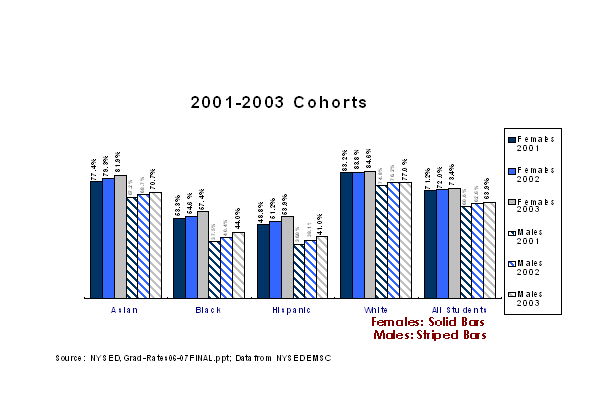Meeting of the Board of Regents | November 2009
|
|
|
|
TO: |
EMSC Committee |
|
FROM: |
John B. King, Jr. |
|
SUBJECT: |
College and Career Readiness Working Group |
|
DATE: |
November 9, 2009 |
|
STRATEGIC GOAL: |
Goal 1 |
|
AUTHORIZATION(S): |
SUMMARY
Issue for Decision
Does the Board of Regents approve the recommendation to create a College and Career Readiness Working Group comprised of Regents, Department staff, and experts from P-12, higher education, and the business community? To improve the alignment of New York State’s diplomas with the knowledge and skills necessary for success in college and the 21st century workplace, the Working Group would be charged with developing recommendations for possible changes to the New York State high school diploma requirements and Regents exams to better align them with college and career readiness as well as a review of the GED policy and program.
Reasons for Consideration
As evidenced by the data on remedial course work and persistence rates, we face major challenges in college and career readiness. Studies provide no consensus on the definition of college readiness and there is misalignment of instructional practices among Pre-K-12 educators and college educators. High school graduation rates, especially for at-risk student populations, are not high enough, college enrollment and persistence rates are low, and college completion rates for these student populations are consistently lower than for other student groups.
It may be time to rethink secondary school design to increase student engagement and to ensure that secondary schools equip students with the skills they will need to succeed in college and the global economy and society of the 21st century. Redesigning secondary school means looking at many issues, including, 1) high school diploma requirements, 2) Regents examinations, 3) seat time requirements vs. earning course credit though demonstration of competency, 4) innovative secondary models including virtual high schools and on-line courses, and 5) alternative secondary models designed to engage students including career and technical education (CTE), science, technology, engineering and mathematics (STEM) programs, arts programs, and early college high school programs. It also means developing standards of excellence for all students, including high performing students, that could possibly include the International Baccalaureate (IB), Advanced Placement tests, the British A-level examinations, and others.
In addition to rethinking secondary education, we need to examine the NYS High School Equivalency Diploma (GED) policy and program in New York State. In 2008, approximately 34,600 students received an Equivalency Diploma instead of a regular high school diploma. New York is one of only two states that do not have prerequisites or charge a fee to take the GED test. New York has the greatest access and opportunity for students to take the test; however, New York also has the lowest pass rate in the country (59.7%). Too many students who are not ready to take the test fail it and become disillusioned. We need to develop new policies that will set our students up for success and provide natural linkages between the GED, the workforce, and/or post-secondary education.
We recommend the creation of a College and Career Readiness Working Group that would be appointed by the Chancellor and comprised of Regents, Department staff, and experts from P-12, higher education, and the business community. This Working Group would be charged with developing recommendations for consideration by the Regents concerning the redesign of secondary education in New York State. The Group would consider the issues described above as well as others in order to make recommendations designed to raise the graduation rates for at-risk students and ensure that all students are prepared for success in college and the global economy.
Background Information
The secondary school system is not working for all of our students as evidenced by the data presented below. Too many students are leaving high school not prepared for success in college or the workplace.

Although the high school graduation rate continues to rise, the current four year graduation rate in New York State is 71%. This means that almost 30% of students in high school will not graduate in four years. The graduation rate is significantly lower for many at-risk student groups, as shown in the chart below:
 The chart below shows that of those students who do graduate from high school, too many at-risk students have earned a local diploma rather than a Regents diploma.
The chart below shows that of those students who do graduate from high school, too many at-risk students have earned a local diploma rather than a Regents diploma.
The charts below show that of those students who graduate from high school, many do not go onto college or are not successful in college. For many at-risk student groups the college enrollment rate and 2nd year persistence rate are too low and the percentage of students who need remedial coursework when they get to college is too high.
New York State
Student Performance Overview
|
Group |
Number in 2002 Cohort (to the nearest hundred) |
4-Year Graduation Rate |
Post- Secondary Enrollment Rate |
Persistence Rate Into Year 2 of College |
|
All Students |
214,600 |
67% |
48% |
37% |
|
Black and Hispanic Males |
38,900 |
40% |
21% |
13% |
|
English Language Learners |
11,000 |
26% |
10% |
7% |
|
Students with Disabilities |
26,700 |
43% |
27% |
16% |
|
Non Black and Hispanic, ELL and SWD |
117,300 |
84% |
67% |
54% |

The persistence rate for students who take remedial courses is significantly lower than for those who do not need these courses.

The six-year college completion rates also show that at-risk student groups are not graduating from college at the same rate that other students are. The table below shows that the overall six-year Baccalaureate graduation rate is 63% while the rate for Black students is 47% and the rate for Hispanic students is 48%. There is still a significant performance gap for at-risk students.
|
6-year Baccalaureate Graduation Rate 2007 |
|
|
All students who enter college |
63% |
|
Black students who enter college |
47% |
|
Hispanic students who enter college |
48% |
Conley, David T. (2007), Redefining College Readiness, Volume 3, Eugene, OR: Educational Policy Improvement Center






 THE STATE EDUCATION DEPARTMENT / THE UNIVERSITY OF THE STATE OF NEW YORK / ALBANY, NY 12234
THE STATE EDUCATION DEPARTMENT / THE UNIVERSITY OF THE STATE OF NEW YORK / ALBANY, NY 12234